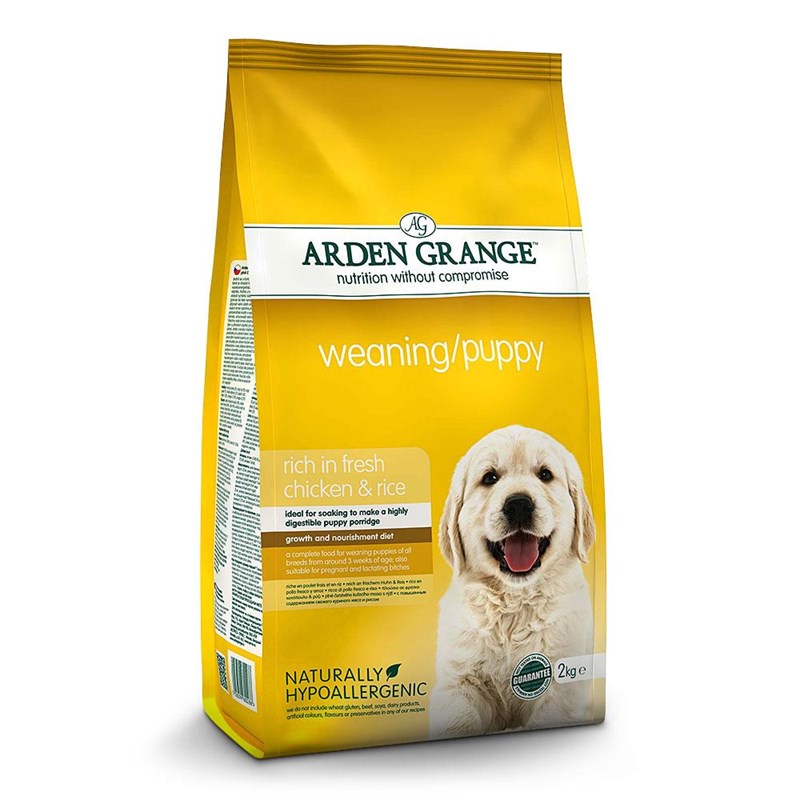Arden Grange Weaning Puppy All breeds from 3 to 8 weeks of age Puppies that require a porridge to introduce them to solids It can also be used for: Older small breed puppies. Recommended for: All breeds from 3 to 8 weeks of age Puppies that require a porridge to introduce them to solids It can also be used for: Small breed puppies older than 8 weeks Puppies of medium breeds from 3 to 12 weeks Lactating or pregnant bitches Small-breed adult dogs with a very low appetite or need to gain weight Nutritional information: Small-size kibble can be easily soaked to form a weaning porridge Calorie-dense smaller portions are ideal for a pup's delicate digestive system High proportion of fresh chicken meat protein of great biological value Complete and balanced nutrition with adequate levels of proteins, fats, minerals and vitamins to support early growth MORE INFORMATION Analytical components: protein 32%, fat 20%, ash 7%, fibre 2.5%, Calcium 1.45%, Phosphorus 1.05%, Omega-3 0.95%, Omega-6 2.87%. Composition: Chicken meat meal 26%, fresh chicken 18%, rice 14%, corn, refined chicken oil, dehydrated whole egg, beet pulp, fish meal, chicken hydrolyzate, krill, yeast, minerals, seed whole flax, FOS prebiotics, MOS prebiotics, cassava extract, glucosamine, MSM, chondroitin, blueberries, nucleotides. Additives (per kg): Nutritional supplements Vitamins: Vitamin A 24,000 IU, Vitamin D3 1,800 IU, Vitamin E 320 IU. Trace elements: zinc chelate of hydrated amino acids 667mg, cupric chelate of hydrated amino acids 133mg, manganese chelate of hydrated amino acids 89mg, anhydrous calcium iodate 3.2mg, selenized yeast (inactivated) 87mg, Antioxidant (rosemary extract). FEEDING INSTRUCTIONS Arden Grange Weaning/Puppy should first be soaked in lukewarm water and mixed to form a smooth slurry. More lukewarm water can be added to achieve the right consistency and for the puppy to lick it off. It is recommended that puppies be fed by the portion control method, which allows individual consumption to be controlled more precisely. We suggest that you let the porridge rest for about 15 minutes and then remove any remains that are not going to be eaten (or given to the mother). This should be repeated at each meal, usually 4 times a day. Remember that age, activity level, character, digestion and metabolic rate can influence the amount of food required. The quantities indicated in the table are only a guide. Make sure that the animal always has fresh and clean water to drink. Recommended daily feeding table Consult the following table for the recommended daily food ration for your pet. Weight Kgs. Grams / Day - Recommended feeding guide, Weaning 12 Weeks 1- 3 83 /176 3- 5 176/ 250 5 -10 250 /402 10 -15 402 /524 15 -20 524 /642 Recommended feeding guide, 3-5 Months 1- 3 78 /167 3 -5 167 /235 5 -10 235 /377 10 -15 377/ 495 15 -20 495/ 603 20 -25 603 /696 Recommended feeding guide, 5-8 Months 1 -3 49 /108 3 -5 108 /152 5- 10 152 /240 10 -15 240 /314 15 -20 314 /382 20 -25 382 /466 Recommended feeding guide, 8-12 Months 1 -3 39/88 3 -5 88/123 5 -10 123/196 10- 15 196/260 15- 20 260/ 314 20 -25 314/363 How to use the Feeding Chart The Arden Grange feeding charts provide an estimate of the recommended daily feeding amount based on the weight of your dog or cat. It is important to remember that this is only a guide and that there are multiple factors that must be taken into account when assessing the nutritional needs of your pet. Activity Level Temperament/Character (stressed animals burn more calories than those in a more relaxed state) Metabolism (every animal has its own metabolism, this means that 2 dogs of the same age, breed and weight could have different daily calorie needs) In order to administer the correct rations, it is advisable to examine your pet's appetite, appearance and faeces. Although it is not pleasant to examine the stool, it is the best indicator of health. The increase in the frequency of deposition of faeces or producing a large amount of excrement are usually symptoms that the animal is receiving more food than it needs. It is important to know the exact weight of your dog or cat, and also to weigh the food. Otherwise, we would have a large margin of error.

